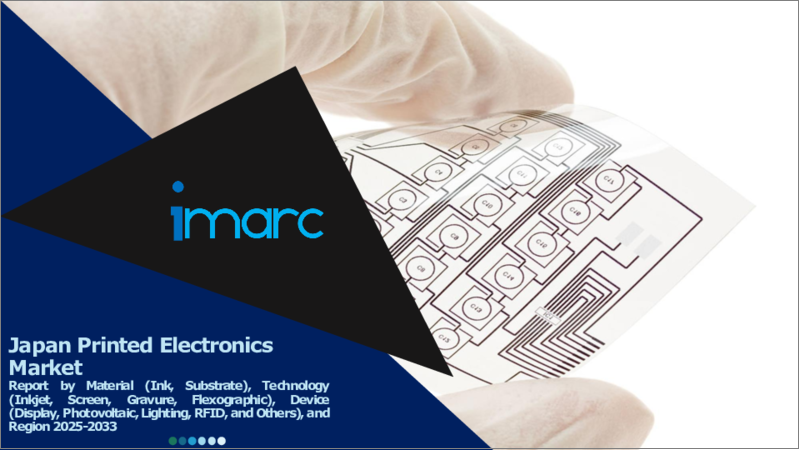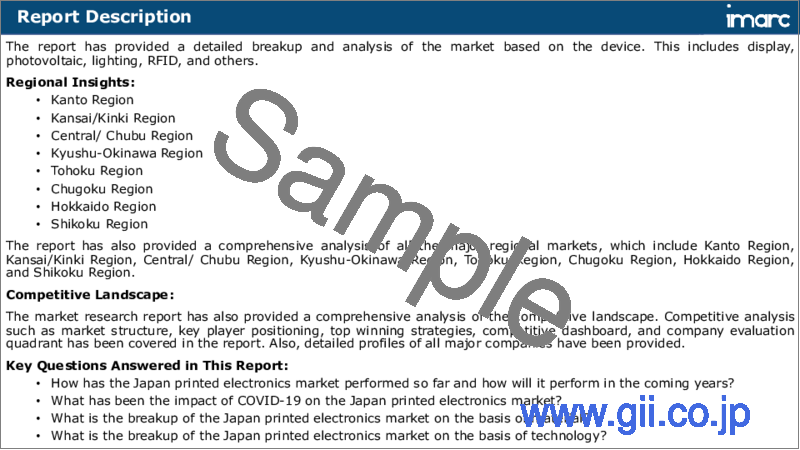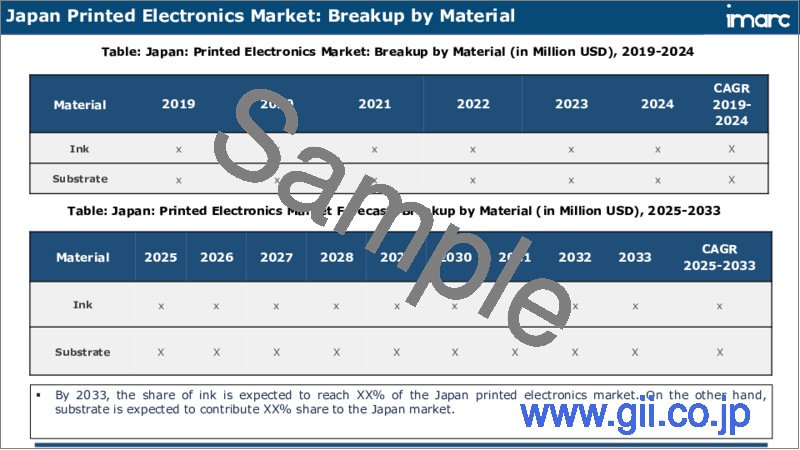|
|
市場調査レポート
商品コード
1747046
プリンテッドエレクトロニクスの日本市場:材料別、技術別、デバイス別、地域別、2025年~2033年Japan Printed Electronics Market Report by Material (Ink, Substrate), Technology (Inkjet, Screen, Gravure, Flexographic), Device (Display, Photovoltaic, Lighting, RFID, and Others), and Region 2025-2033 |
||||||
カスタマイズ可能
|
|||||||
| プリンテッドエレクトロニクスの日本市場:材料別、技術別、デバイス別、地域別、2025年~2033年 |
|
出版日: 2025年06月02日
発行: IMARC
ページ情報: 英文 121 Pages
納期: 5~7営業日
|
全表示
- 概要
- 目次
日本のプリンテッドエレクトロニクスの市場規模は2024年に62億米ドルに達しました。IMARC Groupは、2025年から2033年にかけての成長率(CAGR)は18.1%で、2033年までには310億米ドルに達すると予測しています。技術のインターネット(IoT)における数多くの進歩が、効率的で費用対効果の高い電子製品へのニーズを喚起しており、これが主に市場成長の原動力となっています。
本レポートで扱う主な質問
- 日本のプリンテッドエレクトロニクス市場はこれまでどのように推移してきたか?
- 日本のプリンテッドエレクトロニクス市場にCOVID-19が与えた影響は?
- 日本のプリンテッドエレクトロニクス市場の材料別区分は?
- 日本のプリンテッドエレクトロニクス市場の技術別区分は?
- 日本のプリンテッドエレクトロニクス市場のデバイス別内訳は?
- 日本のプリンテッドエレクトロニクス市場のバリューチェーンにおける各ステージとは?
- 日本のプリンテッドエレクトロニクスの主要な促進要因と課題は?
- 日本のプリンテッドエレクトロニクス市場の構造と主要企業は?
- 日本のプリンテッドエレクトロニクス市場における競合の程度は?
目次
第1章 序文
第2章 調査範囲と調査手法
- 調査の目的
- ステークホルダー
- データソース
- 市場推定
- 調査手法
第3章 エグゼクティブサマリー
第4章 日本のプリンテッドエレクトロニクス市場-イントロダクション
- 概要
- 市場力学
- 業界動向
- 競合情報
第5章 日本のプリンテッドエレクトロニクス市場情勢
- 過去および現在の市場動向(2019年~2024年)
- 市場予測(2025年~2033年)
第6章 日本のプリンテッドエレクトロニクス市場-材料別内訳
- インク
- 基板
第7章 日本のプリンテッドエレクトロニクス市場-技術別内訳
- インクジェット
- 画面
- グラビア
- フレキソ印刷
第8章 日本のプリンテッドエレクトロニクス市場-デバイス別内訳
- 画面
- 太陽光発電
- 照明
- RFID
- その他
第9章 日本のプリンテッドエレクトロニクス市場-競合情勢
- 概要
- 市場構造
- 市場企業のポジショニング
- 主要成功戦略
- 競合ダッシュボード
- 企業評価クアドラント
第10章 主要企業のプロファイル
第11章 日本のプリンテッドエレクトロニクス市場-業界分析
- 促進要因、抑制要因、機会
- ポーターのファイブフォース分析
- バリューチェーン分析
第12章 付録
Japan printed electronics market size reached USD 6.2 Billion in 2024. Looking forward, IMARC Group expects the market to reach USD 31.0 Billion by 2033, exhibiting a growth rate (CAGR) of 18.1% during 2025-2033. Numerous advancements in the Internet of Technology (IoT) are catalyzing the need for efficient and cost-effective electronic products, which is primarily driving the market growth.
Printed electronics entail the creation of electronic devices on substrates like foil, paper, glass, and fabric polymers. This is achieved using inks composed of carbon-based compounds and various printing technologies such as inkjet, flexography, gravure, and screen printing. Common applications of printed electronics encompass wearable devices, flexible keyboards, electronic skin patches, biosensors, display units, Organic Light Emitting Diode (OLED) screens, and photovoltaic cells. In contrast to traditional electronic components, printed electronics offer several advantages: they are more eco-friendly, lightweight, flexible, cost-efficient, and have lower power consumption. Consequently, they enjoy extensive utilization across diverse industries, including aerospace, automotive, healthcare, and consumer electronics.
Japan Printed Electronics Market Trends:
In the context of the Japanese market, there are several key factors contributing to a positive outlook for the printed electronics industry. Firstly, there has been substantial growth in the global electronics sector, which is playing a pivotal role in driving market expansion. This growth is spurred by the increasing demand for next-generation flexible electronic products characterized by energy efficiency, slim profiles, and sustainability, especially in the realm of consumer electronics. Furthermore, the widespread adoption of smart and connected devices is serving as a catalyst for market growth. Consumers are increasingly gravitating toward printed electronics for applications in wearable devices, smart packaging solutions, medical devices, and smart apparel due to their favorable sensing capabilities, data storage features, and efficient data transmission. Innovations such as the utilization of additive manufacturing and screen-printing technologies are acting as additional drivers for market growth. These technologies enable the production of fully electromechanical components with enhanced precision, utilizing various types of inks, including ultraviolet (UV) curable, plastisol, water-based, and solvent-based inks. Additionally, printed sensors and panels find extensive use in the cockpits and navigation systems of aircraft and military vehicles, further bolstering market growth in Japan. These factors will collectively contribute to a favorable market landscape for printed electronics in the country in the coming years.
Japan Printed Electronics Market Segmentation:
Material Insights:
- Ink
- Substrate
Technology Insights:
- Inkjet
- Screen
- Gravure
- Flexographic
Device Insights:
- Display
- Photovoltaic
- Lighting
- RFID
- Others
Competitive Landscape:
The market research report has also provided a comprehensive analysis of the competitive landscape. Competitive analysis such as market structure, key player positioning, top winning strategies, competitive dashboard, and company evaluation quadrant has been covered in the report. Also, detailed profiles of all major companies have been provided.
Key Questions Answered in This Report:
- How has the Japan printed electronics market performed so far and how will it perform in the coming years?
- What has been the impact of COVID-19 on the Japan printed electronics market?
- What is the breakup of the Japan printed electronics market on the basis of material?
- What is the breakup of the Japan printed electronics market on the basis of technology?
- What is the breakup of the Japan printed electronics market on the basis of device?
- What are the various stages in the value chain of the Japan printed electronics market?
- What are the key driving factors and challenges in the Japan printed electronics?
- What is the structure of the Japan printed electronics market and who are the key players?
- What is the degree of competition in the Japan printed electronics market?
Table of Contents
1 Preface
2 Scope and Methodology
- 2.1 Objectives of the Study
- 2.2 Stakeholders
- 2.3 Data Sources
- 2.3.1 Primary Sources
- 2.3.2 Secondary Sources
- 2.4 Market Estimation
- 2.4.1 Bottom-Up Approach
- 2.4.2 Top-Down Approach
- 2.5 Forecasting Methodology
3 Executive Summary
4 Japan Printed Electronics Market - Introduction
- 4.1 Overview
- 4.2 Market Dynamics
- 4.3 Industry Trends
- 4.4 Competitive Intelligence
5 Japan Printed Electronics Market Landscape
- 5.1 Historical and Current Market Trends (2019-2024)
- 5.2 Market Forecast (2025-2033)
6 Japan Printed Electronics Market - Breakup by Material
- 6.1 Ink
- 6.1.1 Overview
- 6.1.2 Historical and Current Market Trends (2019-2024)
- 6.1.3 Market Forecast (2025-2033)
- 6.2 Substrate
- 6.2.1 Overview
- 6.2.2 Historical and Current Market Trends (2019-2024)
- 6.2.3 Market Forecast (2025-2033)
7 Japan Printed Electronics Market - Breakup by Technology
- 7.1 Inkjet
- 7.1.1 Overview
- 7.1.2 Historical and Current Market Trends (2019-2024)
- 7.1.3 Market Forecast (2025-2033)
- 7.2 Screen
- 7.2.1 Overview
- 7.2.2 Historical and Current Market Trends (2019-2024)
- 7.2.3 Market Forecast (2025-2033)
- 7.3 Gravure
- 7.3.1 Overview
- 7.3.2 Historical and Current Market Trends (2019-2024)
- 7.3.3 Market Forecast (2025-2033)
- 7.4 Flexographic
- 7.4.1 Overview
- 7.4.2 Historical and Current Market Trends (2019-2024)
- 7.4.3 Market Forecast (2025-2033)
8 Japan Printed Electronics Market - Breakup by Device
- 8.1 Display
- 8.1.1 Overview
- 8.1.2 Historical and Current Market Trends (2019-2024)
- 8.1.3 Market Forecast (2025-2033)
- 8.2 Photovoltaic
- 8.2.1 Overview
- 8.2.2 Historical and Current Market Trends (2019-2024)
- 8.2.3 Market Forecast (2025-2033)
- 8.3 Lighting
- 8.3.1 Overview
- 8.3.2 Historical and Current Market Trends (2019-2024)
- 8.3.3 Market Forecast (2025-2033)
- 8.4 RFID
- 8.4.1 Overview
- 8.4.2 Historical and Current Market Trends (2019-2024)
- 8.4.3 Market Forecast (2025-2033)
- 8.5 Others
- 8.5.1 Historical and Current Market Trends (2019-2024)
- 8.5.2 Market Forecast (2025-2033)
9 Japan Printed Electronics Market - Competitive Landscape
- 9.1 Overview
- 9.2 Market Structure
- 9.3 Market Player Positioning
- 9.4 Top Winning Strategies
- 9.5 Competitive Dashboard
- 9.6 Company Evaluation Quadrant
10 Profiles of Key Players
- 10.1 Company A
- 10.1.1 Business Overview
- 10.1.2 Product Portfolio
- 10.1.3 Business Strategies
- 10.1.4 SWOT Analysis
- 10.1.5 Major News and Events
- 10.2 Company B
- 10.2.1 Business Overview
- 10.2.2 Product Portfolio
- 10.2.3 Business Strategies
- 10.2.4 SWOT Analysis
- 10.2.5 Major News and Events
- 10.3 Company C
- 10.3.1 Business Overview
- 10.3.2 Product Portfolio
- 10.3.3 Business Strategies
- 10.3.4 SWOT Analysis
- 10.3.5 Major News and Events
- 10.4 Company D
- 10.4.1 Business Overview
- 10.4.2 Product Portfolio
- 10.4.3 Business Strategies
- 10.4.4 SWOT Analysis
- 10.4.5 Major News and Events
- 10.5 Company E
- 10.5.1 Business Overview
- 10.5.2 Product Portfolio
- 10.5.3 Business Strategies
- 10.5.4 SWOT Analysis
- 10.5.5 Major News and Events
11 Japan Printed Electronics Market - Industry Analysis
- 11.1 Drivers, Restraints, and Opportunities
- 11.1.1 Overview
- 11.1.2 Drivers
- 11.1.3 Restraints
- 11.1.4 Opportunities
- 11.2 Porters Five Forces Analysis
- 11.2.1 Overview
- 11.2.2 Bargaining Power of Buyers
- 11.2.3 Bargaining Power of Suppliers
- 11.2.4 Degree of Competition
- 11.2.5 Threat of New Entrants
- 11.2.6 Threat of Substitutes
- 11.3 Value Chain Analysis





